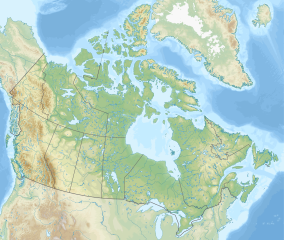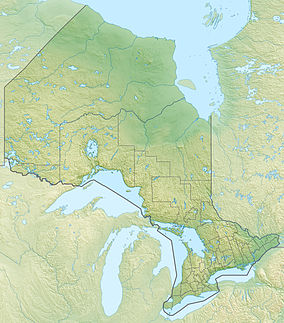Pukaskwa National Park (/ˈpʌkəsɔː/ PUK-ə-saw)[2] is a national park located south of the town of Marathon, Ontario in the Thunder Bay District of northern Ontario, Canada. Established in 1978, Pukaskwa is known for its vistas of Lake Superior and boreal forests. The park covers an area of 1,878 square kilometres (725 sq mi), and protects a part of the longest undeveloped shoreline anywhere on the Great Lakes.
| Pukaskwa National Park | |
|---|---|
| Parc national Pukaskwa | |
 Southern Headland Trail | |
| Location | Ontario, Canada |
| Nearest city | Marathon |
| Coordinates | 48°14′44″N 85°53′18″W / 48.24568°N 85.88821°W |
| Area | 1,878 km2 (725 sq mi) |
| Established | 1978 |
| Visitors | 17,285 (in 2022–23[1]) |
| Governing body | Parks Canada |
 | |
The Hattie Cove Campground is located at the north end of the park and can be accessed via Highway 627, the only road access into the park. There are also a number of backcountry campsites located along the 60 km Coastal Hiking Trail which follows the north shore of Lake Superior. The Coastal Hiking Trail has two suspension bridges; one across the White River at Chigaamiwinigum and one across the Willow River. The Coastal Hiking Trail is part of the long-distance Voyageur Hiking Trail. Backcountry campsites are also located along the Coastal Paddling Route, the White River, and the Pukaskwa River. In 2017, the 24 km Mdaabii Miikna ("go to shore trail" in Ojibwe) was opened as a shorter backcountry alternative to the Coastal Hiking trail. It follows the coastline of Lake Superior in the sheltered Picture Rock Harbour.[3]
Puskaskwa is an Indigenous word with a debatable meaning. Its possible meanings include "eaters of fish," "something evil," or "safe harbour." However, the Ojibway and Cree nations maintain "Pukasu" is the correct spelling. "The word "Pukasu" describes what people do when they cook the marrow inside the bones of animals. Remnants of a carcass are thrown into an open fire and left until any remaining meat has all burned away leaving the marrow cooked.[4]
Flora
editPukaskwa National Park is located in the heart of Canada's boreal forest ecozone. Common tree species in this area include black spruce, white spruce, jack pine, trembling aspen, Eastern white cedar, and white birch. Many plants that grow inside Pukaskwa National Park are typically found in Arctic alpine regions,[5] including encrusted saxifrage, birds-eye primrose, and butterwort. Pukaskwa is home to the northernmost populations of Pitcher's thistle in Canada, with four colonies of the plant existing and self-sustaining on the coastal dune areas within the park.[6] Other rare plant species include Franklin's lady-slipper and mountain huckleberry.[5] Many plants within Pukaskwa also have medicinal and ethnobotanical uses. Eastern white cedar, Labrador-tea, and Chaga all grow within Pukaskwa's area and can be boiled into tea for physical and spiritual health.[7] Pukaskwa is also home to numerous lichen and moss species, including sphagnum, reindeer moss, and lungwort species.[8]
Fauna
editBlack bears, moose, beavers, peregrine falcons, river otters, lynx and timber wolves are found in this park. The park is also home to bald eagles.[9] There was also a small population of woodland caribou but their numbers declined from 30 caribou in the 1970s to about four in 2012 mainly due to wolf predation.[10][11] In early 2017, after previous failures to locate any remaining caribou, researchers turned to advanced thermal imaging technology to survey the area for caribou. This survey revealed caribou are now extirpated from this park. Cougars may also be in the park, but numbers are not yet known.[12]
Climate
editThe park has a humid continental climate (Dfb) under the Köppen climate classification that is strongly influenced by Lake Superior.
| Climate data for Pukaskwa National Park (1981−2010) | |||||||||||||
|---|---|---|---|---|---|---|---|---|---|---|---|---|---|
| Month | Jan | Feb | Mar | Apr | May | Jun | Jul | Aug | Sep | Oct | Nov | Dec | Year |
| Record high °C (°F) | 6.0 (42.8) |
10.0 (50.0) |
17.0 (62.6) |
27.0 (80.6) |
29.0 (84.2) |
30.7 (87.3) |
30.5 (86.9) |
32.0 (89.6) |
25.3 (77.5) |
21.0 (69.8) |
16.5 (61.7) |
9.2 (48.6) |
32.0 (89.6) |
| Mean daily maximum °C (°F) | −7.7 (18.1) |
−4.1 (24.6) |
0.6 (33.1) |
7.2 (45.0) |
13.5 (56.3) |
17.2 (63.0) |
19.5 (67.1) |
20.4 (68.7) |
15.8 (60.4) |
8.8 (47.8) |
1.9 (35.4) |
−4.2 (24.4) |
7.4 (45.3) |
| Daily mean °C (°F) | −13.5 (7.7) |
−10.1 (13.8) |
−5.3 (22.5) |
1.9 (35.4) |
7.8 (46.0) |
11.8 (53.2) |
14.4 (57.9) |
15.6 (60.1) |
11.6 (52.9) |
5.0 (41.0) |
−1.8 (28.8) |
−9.1 (15.6) |
2.4 (36.3) |
| Mean daily minimum °C (°F) | −19.2 (−2.6) |
−16.1 (3.0) |
−11.1 (12.0) |
−3.4 (25.9) |
2.4 (36.3) |
6.3 (43.3) |
9.3 (48.7) |
10.7 (51.3) |
7.3 (45.1) |
1.2 (34.2) |
−5.5 (22.1) |
−13.9 (7.0) |
−2.7 (27.1) |
| Record low °C (°F) | −40 (−40) |
−39 (−38) |
−35 (−31) |
−21 (−6) |
−7.5 (18.5) |
−4.5 (23.9) |
−4.5 (23.9) |
−2.0 (28.4) |
−7 (19) |
−11.5 (11.3) |
−28.5 (−19.3) |
−39.5 (−39.1) |
−40 (−40) |
| Average precipitation mm (inches) | 60.4 (2.38) |
32.7 (1.29) |
36.7 (1.44) |
41.7 (1.64) |
72.4 (2.85) |
84.5 (3.33) |
95.2 (3.75) |
75.9 (2.99) |
106.0 (4.17) |
90.8 (3.57) |
80.0 (3.15) |
59.8 (2.35) |
836.2 (32.92) |
| Average rainfall mm (inches) | 0.64 (0.03) |
1.8 (0.07) |
10.5 (0.41) |
34.3 (1.35) |
71.6 (2.82) |
84.5 (3.33) |
95.2 (3.75) |
75.8 (2.98) |
105.9 (4.17) |
83.5 (3.29) |
47.7 (1.88) |
5.1 (0.20) |
616.5 (24.27) |
| Average snowfall cm (inches) | 59.8 (23.5) |
30.9 (12.2) |
26.3 (10.4) |
7.3 (2.9) |
0.88 (0.35) |
0.0 (0.0) |
0.0 (0.0) |
0.09 (0.04) |
0.13 (0.05) |
7.3 (2.9) |
32.3 (12.7) |
54.7 (21.5) |
219.7 (86.5) |
| Average precipitation days (≥ 0.2 mm) | 14.6 | 10.9 | 9.0 | 8.4 | 13.3 | 13.6 | 15.6 | 14.3 | 17.2 | 17.6 | 15.6 | 13.9 | 164 |
| Average rainy days (≥ 0.2 mm) | 0.42 | 0.58 | 1.8 | 7.3 | 12.9 | 13.6 | 15.6 | 14.2 | 17.2 | 16.2 | 7.6 | 1.0 | 108.4 |
| Average snowy days (≥ 0.2 cm) | 14.0 | 9.6 | 6.8 | 2.7 | 0.33 | 0.0 | 0.0 | 0.08 | 0.07 | 2.2 | 9.3 | 13.4 | 58.4 |
| Source: Environment Canada[13] | |||||||||||||
Rivers in the park include the:
The Pic River enters Lake Superior just north of the park.
The highest point in the park is the peak of Tip Top Mountain which rises to 641 meters / 2106 feet.[14]
Thousand year old rock structures known as Pukaskwa Pits which were created by the original inhabitants of this area can be found on many of the park's cobblestone beaches.
The most recent State of the Park Report for Pukaskwa National Park was published in 2008.
See also
editExternal links
edit- Official Parks Canada site
- Watch the short documentary by Bill Mason Pukaskwa National Park
- 2008 State of the Park Report
Footnotes
edit- ^ Canada, Parks. "Parks Canada attendance 2022_23 - Parks Canada attendance 2022_23 - Open Government Portal". open.canada.ca. Retrieved 2024-05-07.
- ^ "The Pukaskwa Coastal Trail: a hike that's breathtaking in more ways than one". The Independent. March 31, 2016. Retrieved September 17, 2017.
- ^ Parks Canada Agency, Government of Canada (2020-07-30). "Backcountry hiking - Pukaskwa National Park". www.pc.gc.ca. Retrieved 2021-02-17.
- ^ "Origin of the name Pukaskwa - Pukaskwa National Park". 27 January 2017.
- ^ a b Parks Canada Agency, Government of Canada (2020-12-22). "Forests - Pukaskwa National Park". www.pc.gc.ca. Retrieved 2021-02-15.
- ^ Parks Canada Agency, Government of Canada (2017-01-25). "Pitcher's Thistle restoration - Pukaskwa National Park". www.pc.gc.ca. Retrieved 2021-02-15.
- ^ Uprety, Yadav; Asselin, Hugo; Dhakal, Archana; Julien, Nancy (2012-01-30). "Traditional use of medicinal plants in the boreal forest of Canada: review and perspectives". Journal of Ethnobiology and Ethnomedicine. 8 (1): 7. doi:10.1186/1746-4269-8-7. ISSN 1746-4269. PMC 3316145. PMID 22289509.
- ^ Brinker, Samuel (September 2018). "Climate Change Vulnerability Assessment of Species in the Ontario Great Lakes Basin. Climate Change Research Report CCRR-48" (PDF). Ministry of Natural Resources and Forestry (Ontario). Retrieved February 15, 2021.
- ^ Parks Canada Agency, Government of Canada (2018-02-22). "Bald eagle (Haliaeetus leucocephalus) - Pukaskwa National Park". www.pc.gc.ca. Retrieved 2022-01-01.
- ^ Foster & Harris 2012, p. ii.
- ^ Bergerud 2007, p. 46.
- ^ "Rare cougar spotting in northwestern Ontario national park like 'needle in a haystack'". Canadian Broadcasting Corporation. 2022-07-21. Archived from the original on 2023-01-18.
- ^ "Pukaskwa National park". Canadian Climate Normals 1981–2010. Environment Canada. Archived from the original on 2020-07-17. Retrieved September 29, 2013.
- ^ Tip Top Mountain - Peakbagger.com
References
edit- Bergerud, Arthur T. (2007), "The need for the management of wolves — an open letter" (PDF), Rangifer, Special Issue, 27 (17): 39–49, doi:10.7557/2.27.4.319
- Foster, Robert F.; Harris, Allan G. (19 July 2012), Environmental Assessment for the Marathon PGM-Cu Project at Marathon, Ontario (PDF), Supporting Information Document No. 26: Assessment of impacts on Woodland Caribou, Thunder Bay, Ontario: Stillwater Canada Inc., retrieved 23 September 2014 Pukaskwa National Parks’ population has "declined from approximately 30 caribou in the 1970s to an estimated four currently, largely due to predation by wolves and possibly black bears."

